Boyle J.A. The Cambridge History of Iran, Volume 5: The Saljuq and Mongol Periods
Подождите немного. Документ загружается.

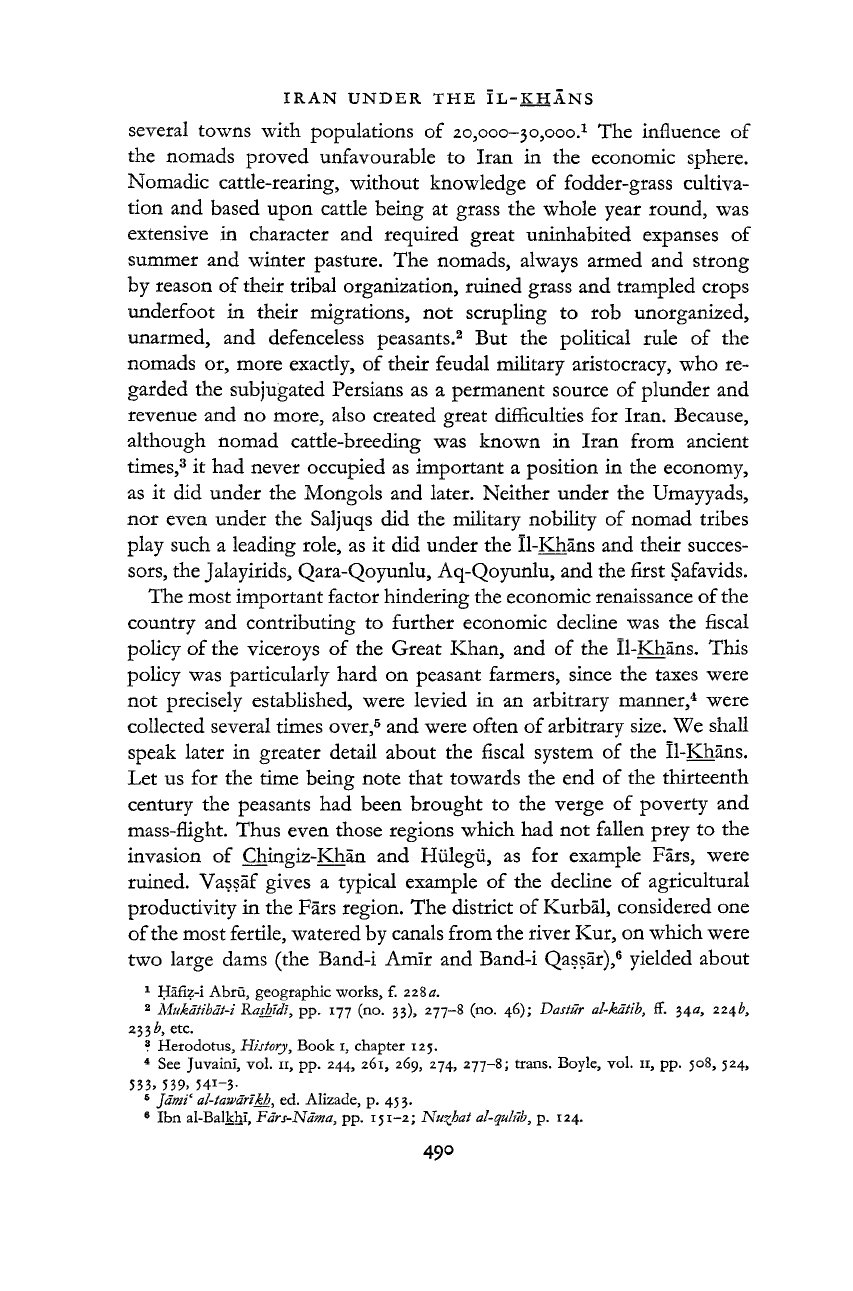
IRAN
UNDER
THE
IL-KHANS
490
several
towns with populations
of
2o,ooo-3o,ooo.
1
The
influence
of
the nomads proved unfavourable
to
Iran
in the
economic sphere.
Nomadic cattle-rearing, without knowledge
of
fodder-grass cultiva-
tion
and
based upon cattle being
at
grass
the
whole year round, was
extensive
in
character
and
required great uninhabited expanses
of
summer
and
winter pasture.
The
nomads, always armed
and
strong
by
reason of their tribal organization, ruined grass and trampled crops
underfoot
in
their migrations,
not
scrupling
to rob
unorganized,
unarmed,
and
defenceless peasants.
2
But the
political rule
of the
nomads
or,
more exactly,
of
their feudal military aristocracy, who
re-
garded
the
subjugated Persians
as a
permanent source
of
plunder
and
revenue
and no
more, also created great difficulties
for
Iran.
Because,
although nomad cattle-breeding
was
known
in
Iran
from ancient
times,
3
it
had never occupied
as
important
a
position
in the
economy,
as
it did
under
the
Mongols
and
later. Neither under
the
Umayyads,
nor even under
the
Saljuqs
did the
military nobility
of
nomad tribes
play
such
a
leading role,
as it did
under
the
Il-Khans
and
their succes-
sors, the Jalayirids, Qara-Qoyunlu, Aq-Qoyunlu, and the first Safavids.
The
most important factor hindering the economic renaissance of the
country
and
contributing
to
further economic decline was
the
fiscal
policy
of the viceroys
of the
Great Khan,
and of the
Il-Khans. This
policy
was particularly hard
on
peasant farmers, since
the
taxes were
not precisely established, were levied
in an
arbitrary manner,
4
were
collected
several times over,
5
and were often of arbitrary
size.
We shall
speak later
in
greater detail about
the
fiscal system
of the
Il-Khans.
Let
us for the
time being note
that
towards
the end of
the
thirteenth
century
the
peasants
had
been brought
to the
verge
of
poverty
and
mass-flight. Thus even those regions which had
not
fallen prey
to the
invasion
of
Chingiz-Khan
and
Hiilegu,
as for
example Fars, were
ruined.
Vassaf
gives
a
typical example
of the
decline
of
agricultural
productivity
in
the Fars region. The district of Kurbal, considered one
of
the most fertile, watered by canals from the river Kur, on which were
two
large dams
(the
Band-i Amir
and
Band-i Qassar),
6
yielded about
1
Hafiz-i Abru, geographic works,
f. 2280.
2
Mukatibat-i Rashfdi, pp. 177 (no. 33), 277-8 (no. 46); Dastur al-kdtib,
ff. 34^,
224b,
233 b,
etc.
?
Herodotus,
History,
Book
1,
chapter
125.
4
See
Juvaini, vol. 11,
pp. 244, 261, 269, 274,
277-8;
trans.
Boyle,
vol.
11,
pp. 508, 524,
533,
539,
541-3-
6
J
ami' al-tawarikb, ed.
Alizade,
p. 453.
6
Ibn
al-Balkhi,
Fdrs-Ndma, pp.
151-2;
Nu^hat al-qulub, p. 124.
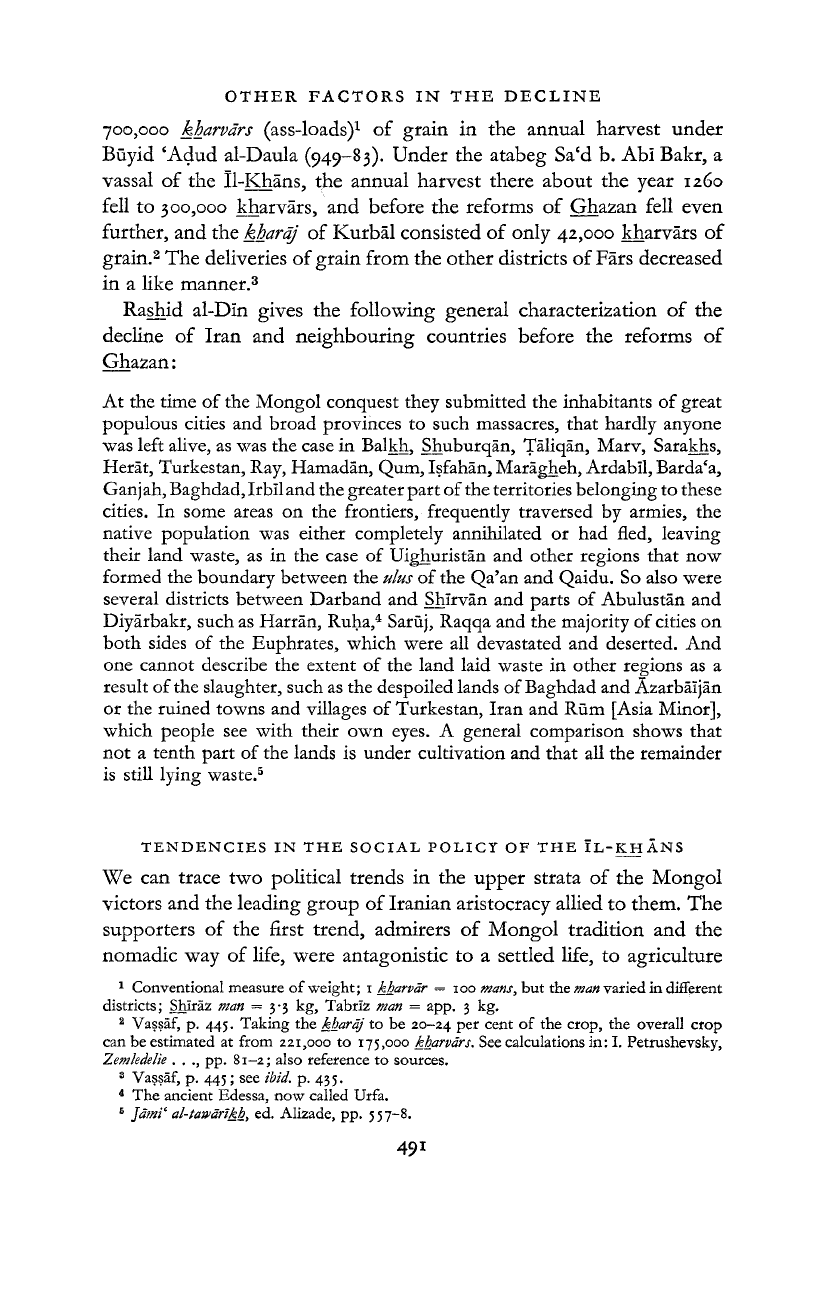
OTHER
FACTORS
IN THE
DECLINE
700,000
kharvars
(ass-loads)
1
of
grain
in the
annual harvest under
Buyid
'Adud al-Daula (949-83). Under
the
atabeg Sa'd b. Abi Bakr,
a
vassal
of
the Il-Khans,
the
annual harvest there about
the
year 1260
fell
to
300,000
kharvars,
and
before
the
reforms
of
Ghazan
fell
even
further, and the khardj of Kurbal consisted of only
42,000
kharvars of
grain.
2
The deliveries of grain from the other districts of Fars decreased
in
a
like manner.
3
Rashid al-Din
gives
the
following general characterization
of the
decline
of
Iran
and
neighbouring countries before
the
reforms
of
Ghazan:
At
the time of the Mongol conquest they submitted the inhabitants of great
populous cities and broad provinces
to
such massacres,
that
hardly anyone
was
left
alive,
as was the case in Balkh, Shuburqan, Taliqan, Marv, Sarakhs,
Herat, Turkestan,
Ray,
Hamadan,
Qum,
Isfahan, Maragheh,
Ardabil,
Barda'a,
Ganjah,
Baghdad,
Irbil and the greater
part
of
the territories
belonging
to these
cities.
In
some areas
on the
frontiers, frequently traversed
by
armies,
the
native population was either completely annihilated
or had
fled, leaving
their land waste, as
in
the case of Uighuristan and other regions
that
now
formed the boundary between the
ulus
of the Qa'an and Qaidu. So also were
several
districts between Darband and Shirvan and
parts
of Abulustan and
Diyarbakr,
such as Harran, Ruha,
4
Saruj, Raqqa and the majority of
cities
on
both sides of the Euphrates, which were all devastated and deserted. And
one cannot describe the extent of the land laid waste
in
other regions
as a
result
of
the slaughter, such as the despoiled lands
of
Baghdad
and Azarbaijan
or the ruined towns and
villages
of Turkestan,
Iran
and Rum
[Asia
Minor],
which
people see with their own
eyes.
A
general comparison shows
that
not
a
tenth
part
of the lands
is
under cultivation and
that
all the remainder
is
still lying waste.
5
TENDENCIES
IN THE
SOCIAL POLICY
OF THE
IL-KHANS
We
can trace two political
trends
in the
upper
strata
of
the Mongol
victors
and the leading group of Iranian aristocracy allied to them. The
supporters
of the
first
trend,
admirers
of
Mongol tradition
and the
nomadic way of
life,
were antagonistic
to a
settled
life,
to
agriculture
1
Conventional measure
of
weight;
1 kharvdr = 100 mans, but
the man varied
in
different
districts; Shiraz
man = 3-3 kg,
Tabriz
man = app. 3 kg.
2
Vassaf,
p. 445.
Taking
the khardj to be 20-24 per
cent
of the
crop,
the
overall crop
can
be
estimated
at
from
221,000 to 175,000 kharvars.
See calculations in:
I.
Petrushevsky,
Zemledelie
. . ., pp. 81-2;
also reference
to
sources.
3
Vassaf,
p. 445; see ibid, p. 435.
4
The ancient Edessa, now called Urfa.
5
Jdmi
6
al-tawdrikh, ed.
Alizade,
pp.
5 5
7-8.
491
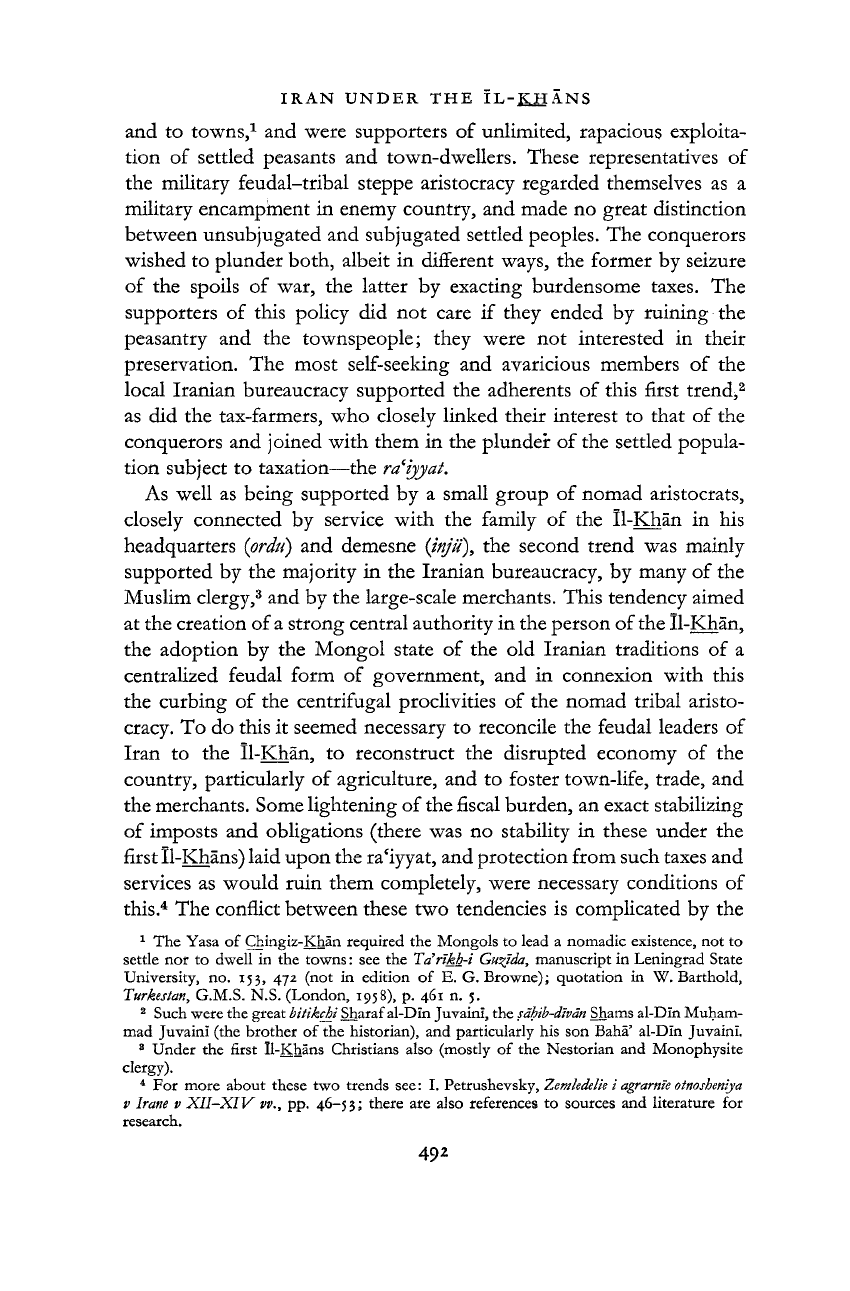
IRAN
UNDER
THE
ÍL-KHANS
492
and
to
towns,
1
and
were supporters
of
unlimited, rapacious exploita-
tion
of
settled peasants
and
town-dwellers. These representatives
of
the military feudal-tribal steppe aristocracy regarded themselves
as a
military encampment
in
enemy country, and made no great distinction
between
unsubjugated and subjugated settled peoples. The conquerors
wished
to plunder both, albeit
in
different
ways,
the
former by seizure
of
the
spoils
of
war,
the
latter
by
exacting burdensome taxes.
The
supporters
of
this policy
did not
care
if
they ended
by
ruining
the
peasantry
and the
townspeople; they were
not
interested
in
their
preservation.
The
most self-seeking
and
avaricious members
of the
local
Iranian bureaucracy supported
the
adherents
of
this first
trend,
2
as did
the
tax-farmers, who
closely
linked their interest
to
that
of
the
conquerors and joined with them
in
the plunder of the settled popula-
tion subject
to
taxation—the
ra'iyyat.
As
well
as
being supported
by a
small group of nomad aristocrats,
closely
connected
by
service with
the
family
of the
Il-Khan
in his
headquarters
(prdu)
and
demesne (inju),
the
second
trend
was mainly
supported by the majority
in
the Iranian bureaucracy,
by
many of the
Muslim
clergy,
3
and by the large-scale merchants. This tendency aimed
at the creation of
a
strong central authority in the person of the Il-Khan,
the adoption
by the
Mongol state
of the old
Iranian traditions
of a
centralized feudal form
of
government,
and in
connexion with this
the curbing
of
the centrifugal proclivities
of
the nomad tribal aristo-
cracy.
To do this
it
seemed necessary
to
reconcile
the
feudal leaders
of
Iran
to the
Il-Khan,
to
reconstruct
the
disrupted economy
of the
country, particularly
of
agriculture, and
to
foster town-life, trade, and
the merchants. Some lightening of the
fiscal
burden, an exact stabilizing
of
imposts
and
obligations (there was
no
stability
in
these under
the
first
Il-Kháns)
laid upon the ra
c
iyyat, and protection from such taxes and
services
as
would ruin them completely, were necessary conditions
of
this.
4
The conflict between these two tendencies
is
complicated by
the
1
The
Yasa
of
Chingiz-Khán required
the
Mongols
to
lead
a
nomadic existence,
not to
settle
nor to
dwell
in the
towns: see
the
Tarikh-i
Gualda,
manuscript
in
Leningrad State
University,
no. 153, 472 (not in
edition
of
E.G.Browne); quotation
in W.
Barthold,
Turkestan,
G.M.S.
N.S. (London,
1958),
p. 461 n. 5.
2
Such were
the
great
bitikchi
Sharaf al-Din Juvaini,
the
sahib-divan
Shams al-Din Muham-
mad Juvaini
(the
brother
of the
historian),
and
particularly
his son
Baha' al-Din Juvaini.
8
Under
the
first Il-Kháns Christians also (mostly
of the
Nestorian
and
Monophysite
clergy).
4
For
more about
these
two
trends
see: I.
Petrushevsky,
Zemledelie
i
agrarni'e
otnosheniya
v Irane v XII-XIV vv., pp.
46-53;
there
are
also references
to
sources
and
literature
for
research.

TENDENCIES
IN THE
SOCIAL
POLICY
OF THE IL-KHANS
conflict
between the pristine
trends
of the Iranian Middle
Ages,
towards
feudal
disintegration and feudal centralization.
A
policy in the spirit of the first tendency predominated under
the first six Il-Khans. For this reason, although there was no lack of
attempts by individual rulers to rebuild cities and irrigation net-
works,
nevertheless these attempts were not successful, because of the
policy
of unbounded exploitation of the ra'iyyat—both peasant and
city-dweller.
Since the work of construction was carried out by
unpaid forced labour, it only laid an extra burden upon the ra'iyyat,
who
were ruined previous to this, and in general such work was not
completed.
1
The
second
trend
gained the upper hand in the ulus of the Il-Khans
during the reign of
Ghazan,
from 1295 to 1304. His
vizier,
the historian,
Shafi'ite
theologian and encyclopaedist Rashid al-Din Fadl
Allah
Hamadani
(1247-1318),
who carried out the reforms of this Il-Khan,
was
the most notable representative and ideologist of this policy. After
the publication of the correspondence of Rashid al-Din, we cannot
doubt but
that
his was the initiative in the reforms of Ghazan. In a
letter to his son Shihab al-Din, governor of Khuzistan, Rashid al-Din
expressed
in the following words the idea
that
it was necessary to keep
the well-being of the ra'iyyat up to a certain
level,
since they were the
fundamental payers of taxes:
It is fitting
that
rulers have three exchequers; firstly of money; secondly of
weapons;
thirdly of food and clothing. And these exchequers are named the
exchequers
of expenditure. But the exchequer of income is the
ra'iyyat
them-
selves,
since
the treasuries
that
I
have mentioned are
filled
by their good efforts
and their economies. And if they are ruined, the king
will
have no revenue.
After
all, if you look into the matter, the basis of administration is justice,
for
if, as they say, the revenue of the ruler is from the army, and the govern-
ment
(saltanat)
has no revenue but
that
paid by the army,
2
yet an army is
created by means of taxation (md/)
y
and there is no army without taxation.
Now
tax
is
paid by the
ra
c
iyyat
y
there being no tax
that
is
not paid
by
the
ra'iyyat.
And
the
raHyyat
are preserved by justice. There are no
ra'iyyat,
if there is no
justice.
3
This
same idea is expressed by Ghazan in a speech made to amirs, i.e.
to the Mongol-Turkish military and nomad aristocracy. In this speech
he says amongst other things:
1
Jdmt
(
al-tawdrikh, ed.
Alizade,
p. 558; cf.
Saifi,
pp. 440, 444.
2
That is, out of
plunder,
one-fifth of which went to the
state.
3
Mukdtabdt-iRashFdi,
pp.
118-19
(no. 22).
493
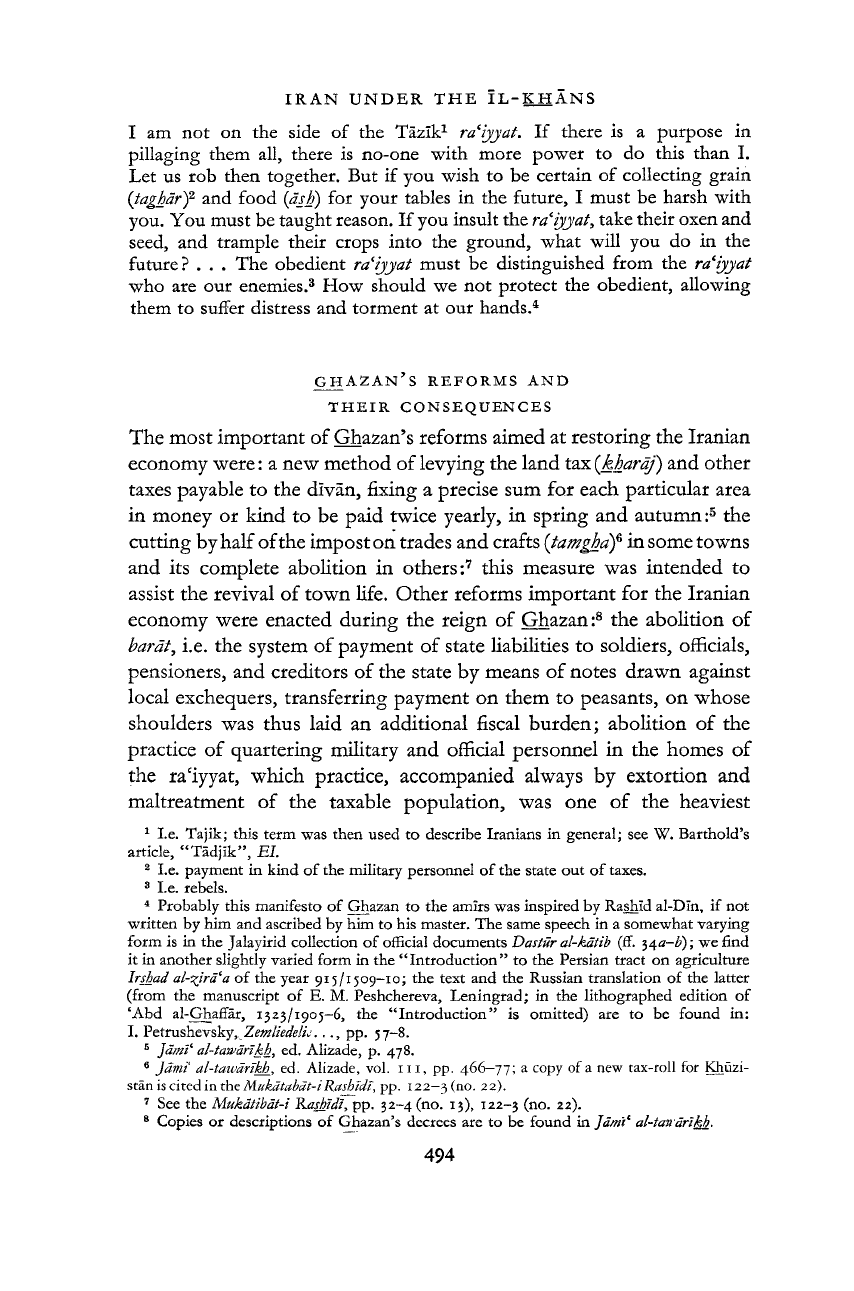
IRAN
UNDER
THE
ÏL-KHÂNS
I
am not on the
side
of the
Tazik
1
ra'iyyat.
If
there
is a
purpose
in
pillaging
them all, there
is
no-one with more power
to do
this
than
I.
Let
us rob
then together. But
if
you wish
to be
certain
of
collecting grain
(taghar)
2
and
food
(ash)
for
your tables
in the
future,
I
must
be
harsh with
you.
You must be taught reason. If
you
insult the
ra'iyyat^
take their oxen and
seed,
and
trample their crops into
the
ground, what
will
you do in the
future?
. . .
The obedient
ra'iyyat
must
be
distinguished from
the
ra'iyyat
who
are our
enemies.
3
How should we
not
protect
the
obedient, allowing
them
to
suffer distress and torment
at
our hands.
4
GHAZAN'S
REFORMS
AND
THEIR
CONSEQUENCES
The
most important of Ghazan's reforms aimed
at
restoring the Iranian
economy
were:
a
new method of
levying
the land tax (khardj) and other
taxes
payable
to the
divan, fixing
a
precise sum
for
each particular area
in money
or
kind
to be
paid twice yearly,
in
spring
and
autumn:
5
the
cutting
by
half
of
the impost on trades and crafts {tamghdf in some towns
and
its
complete abolition
in
others:
7
this measure
was
intended
to
assist
the
revival of town
life.
Other reforms important
for the
Iranian
economy
were enacted during
the
reign
of
Ghazan:
8
the
abolition
of
bardt,
i.e.
the
system of payment
of
state liabilities
to
soldiers,
officials,
pensioners,
and
creditors
of
the state
by
means of notes drawn against
local
exchequers, transferring payment
on
them
to
peasants,
on
whose
shoulders
was
thus
laid
an
additional fiscal burden; abolition
of the
practice
of
quartering military
and
official
personnel
in the
homes
of
the ra'iyyat, which practice, accompanied always
by
extortion
and
maltreatment
of the
taxable population,
was one of the
heaviest
1
I.e.
Tajik; this term was then used
to
describe Iranians
in
general;
see W.
Barthold's
article,
"Tadjik",
EI.
2
I.e.
payment
in
kind
of the
military personnel
of the
state
out of
taxes.
3
I.e.
rebels.
4
Probably this manifesto
of
Ghazan
to the
amirs was inspired
by
Rashid al-DIn,
if not
written
by him and
ascribed
by him to his
master. The same speech
in a
somewhat varying
form
is in the
Jalayirid collection
of
official
documents
Dastur al-kdtib (ff. ^a-b); we
find
it
in
another slightly varied form
in the
"Introduction"
to the
Persian tract
on
agriculture
Irshad al-zjrd'a of the
year
915/1509-10;
the
text
and the
Russian translation
of the
latter
(from
the
manuscript
of E. M.
Peshchereva, Leningrad;
in the
lithographed edition
of
*Abd
al-Ghaffar,
1323/1905-6,
the
"Introduction"
is
omitted)
are to be
found
in:
I. Petrushevsky,
Zemliedelu..., pp. 57-8.
5
Jam?
al-tawdrikh,
ed.
Alizade,
p. 478.
6
J
ami al-tawdrikh, ed.
Alizade,
vol.
111,
pp. 466-77; a
copy
of
a
new
tax-roll
for
Khuzi-
stan
is
cited
in
the
Mukdtabdt-i
Rashidi,
pp.
122—3
(
no
-
22
)-
7
See the
Mukdtibdt-i
Rashfdl,
pp. 32-4
(no.
13), 122-3 (no.
22).
8
Copies
or
descriptions
of
Ghazan's decrees
are to be
found
in Jam? al-tandrlkb.
494
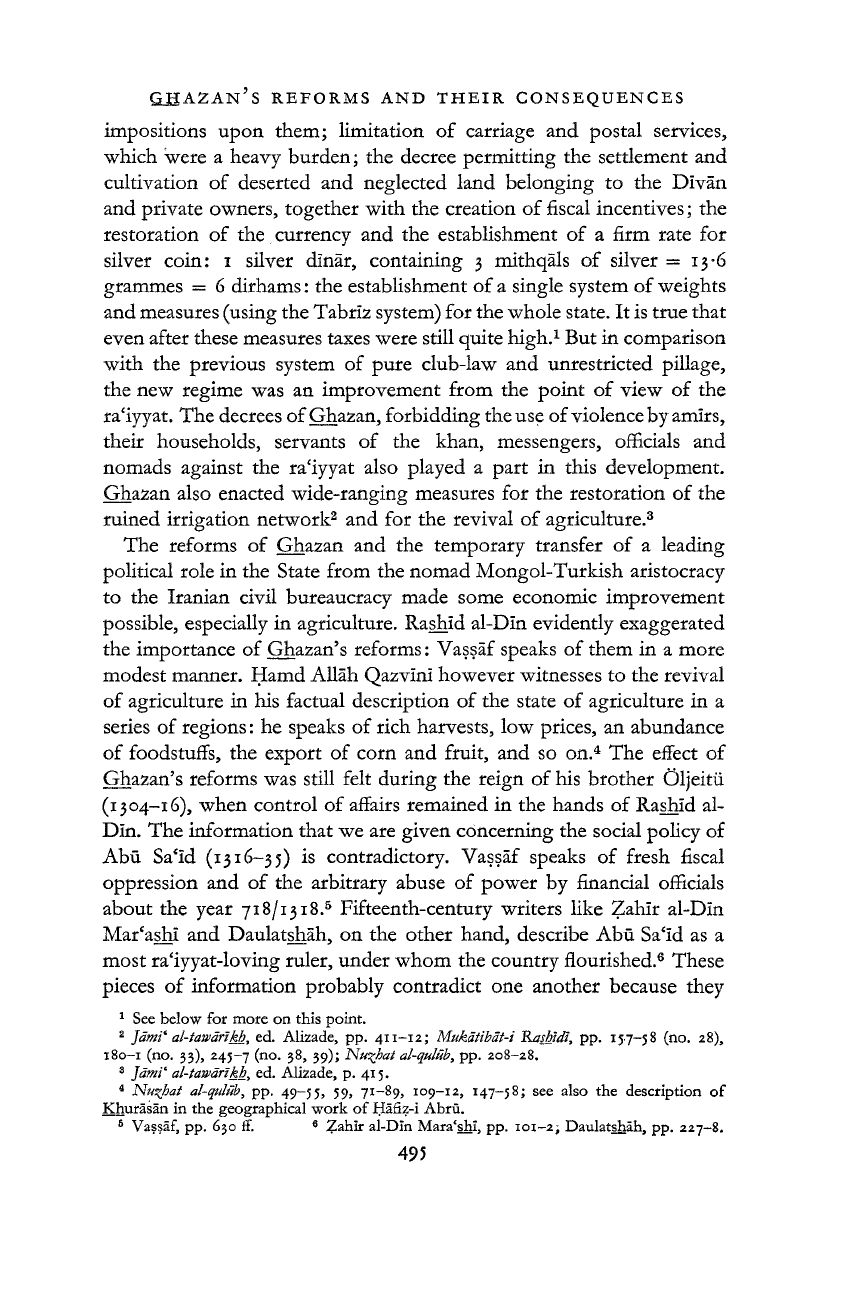
QUAZAN'S
REFORMS
AND
THEIR
CONSEQUENCES
impositions upon them; limitation of carriage and postal services,
which
were a heavy burden; the decree permitting the settlement and
cultivation
of deserted and neglected land belonging to the Divan
and private owners, together with the creation of fiscal incentives; the
restoration of the currency and the establishment of a firm
rate
for
silver
coin: i silver dinar, containing 3 mithqals of silver = 13-6
grammes = 6 dirhams: the establishment of a single system of weights
and measures (using the Tabriz system) for the whole state. It is
true
that
even
after these measures taxes were still quite high.
1
But in comparison
with
the previous system of pure club-law and unrestricted pillage,
the new regime was an improvement from the point of
view
of the
ra
c
iyyat.
The decrees of
Ghazan,
forbidding the use
of
violence
by amirs,
their households, servants of the khan, messengers, officials and
nomads against the ra'iyyat also played a
part
in this development.
Ghazan
also enacted wide-ranging measures for the restoration of the
ruined irrigation network
2
and for the revival of agriculture.
3
The
reforms of Ghazan and the temporary transfer of a leading
political
role in the State from the nomad Mongol-Turkish aristocracy
to the Iranian
civil
bureaucracy made some economic improvement
possible,
especially in agriculture. Rashid al-Din evidently exaggerated
the importance of Ghazan's reforms:
Vassaf
speaks of them in a more
modest manner. Hamd
Allah
Qazvini however witnesses to the revival
of
agriculture in his factual description of the
state
of agriculture in a
series of regions: he speaks of rich harvests, low prices, an abundance
of
foodstuffs, the export of corn and fruit, and so on.
4
The effect of
Ghazan's
reforms was still felt during the reign of his brother Oljeitii
(1304-16),
when control of affairs remained in the hands of Rashid al-
Din.
The information
that
we are given concerning the social policy of
Abu.
Sa'id
(1316-35)
is contradictory.
Vassaf
speaks of fresh fiscal
oppression and of the arbitrary abuse of power by financial officials
about the year
718/1318.
5
Fifteenth-century writers like Zahir al-Din
Mar'ashi and Daulatshah, on the other hand, describe Abu. Sa'Id as a
most ra'iyyat-loving ruler, under whom the country flourished.
6
These
pieces
of information probably contradict one another because they
1
See below for more on this point.
2
]dmi
i
al-tawdrlkb. ed.
Alizade,
pp.
411-12;
Mukdtihdt-i Rasbtdz, pp.
157-58
(no. 28),
180-1 (no.
33), 245-7 (
no
- 3
8
> 39); Nu^bat
al-quliib,
pp. 208-28.
3
J
ami*
al-tawdrikh, ed.
Alizade,
p. 415.
4
Nu^hat al-qulub, pp. 49-55, 59,
71-89,
109-12,
147-58;
see
also
the
description
of
Khurasan in the geographical work of Hafiz-i Abru.
6
Vassaf, pp. 630 ff.
6
£ahir
al-Din Mara'shi, pp.
101-2;
Daulatshah, pp.
227-8.
495
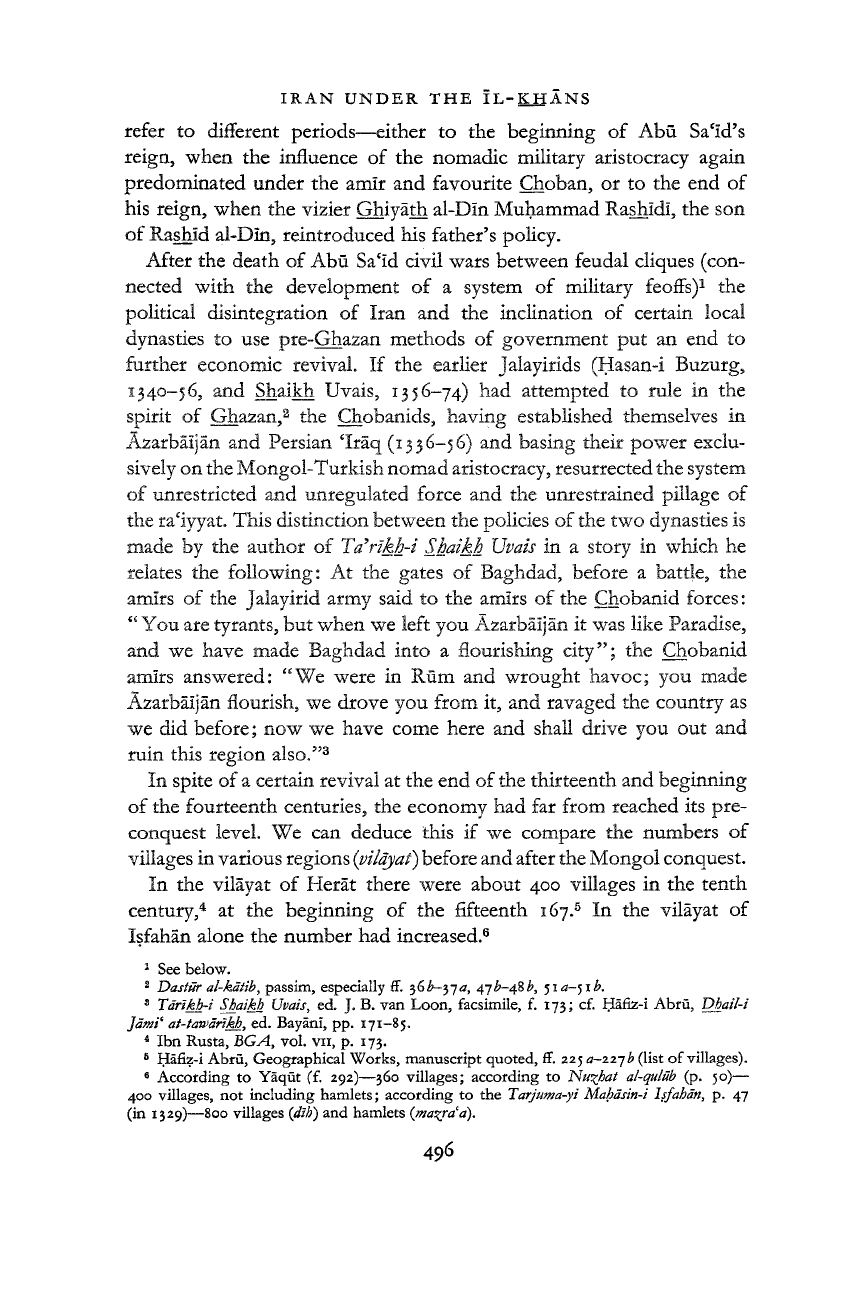
IRAN
UNDER
THE
IL-KJSANS
496
refer
to
different periods—either
to the
beginning
of
Abu. Sa'Id's
reign, when
the
influence
of the
nomadic military aristocracy again
predominated
under
the
amir and favourite Choban,
or to the end of
his reign, when the vizier Ghiyath al-Dln Muhammad Rashldl, the son
of
Rashld al-Dln, reintroduced his father's policy.
After
the death of
Abu.
Sa'id
civil
wars between feudal cliques (con-
nected with
the
development
of a
system
of
military
feoffs)
1
the
political
disintegration
of
Iran
and the
inclination
of
certain local
dynasties
to use
pre-Ghazan methods
of
government
put an end to
further economic revival.
If the
earlier Jalayirids (Hasan-i Buzurg,
1340-56,
and
Shaikh
Uvais,
1356-74)
had
attempted
to
rule
in the
spirit
of
Ghazan,
2
the
Chobanids, having established themselves
in
Azarbaijan
and
Persian
'Iraq
(1336-56) and basing their power exclu-
sively
on the Mongol-Turkish nomad aristocracy, resurrected the system
of
unrestricted
and
unregulated force
and the
unrestrained pillage
of
the ra'iyyat. This distinction between the policies of the two dynasties is
made
by the
author
of
Tcfrikh-i Shaikh Uvais
in a
story
in
which
he
relates
the
following:
At the
gates
of
Baghdad, before
a
battle,
the
amirs
of
the Jalayirid army said
to the
amirs
of
the Chobanid forces:
" You
are tyrants, but when we left you Azarbaijan
it
was like Paradise,
and
we
have made Baghdad into
a
flourishing city";
the
Chobanid
amirs answered: "We were
in
Rum
and
wrought havoc; you made
Azarbaijan
flourish, we drove you from it, and ravaged the country
as
we
did before; now we have come here
and
shall drive you
out and
ruin
this region also."
3
In spite of a certain revival
at
the end of the
thirteenth
and beginning
of
the fourteenth centuries, the economy had
far
from reached its pre-
conquest
level.
We can
deduce this
if
we compare
the
numbers
of
villages
in various regions
(vilayat)
before and after the Mongol conquest.
In
the
vilayat
of
Herat
there
were about
400
villages
in the
tenth
century,
4
at the
beginning
of the
fifteenth 167.
5
In the
vilayat
of
Isfahan alone the number had increased.
6
1
See below.
2
Das
fur al-kdtib,
passim, especially
ff.
36
£-37
¿2,
47^-48^,
51
¿7-51
b.
3
Tarikh-i Shaikh Uvais, ed. J.
B.
van
Loon, facsimile,
f. 173; cf.
Hafiz-i Abru,
Dhail-i
Jam?
at-tawdrtkhy
ed.
Bayani,
pp.
171-85.
*
Ibn
Rusta,
EGA,
vol.
vn, p. 173.
6
Hafiz-i Abru, Geographical Works,
manuscript
quoted,
ff. 225 a-zz-jb
(list
of
villages).
6
According
to
Yaqut
(f. 292)—360
villages; according
to Nu^hat al-qulub (p. 50)—
400
villages,
not
including hamlets; according
to the Tarjuma-yi Mahasin-i Isfahan, p. 47
(in
1329)—800
villages
(dlh) and
hamlets
{ma^ra
i
d).
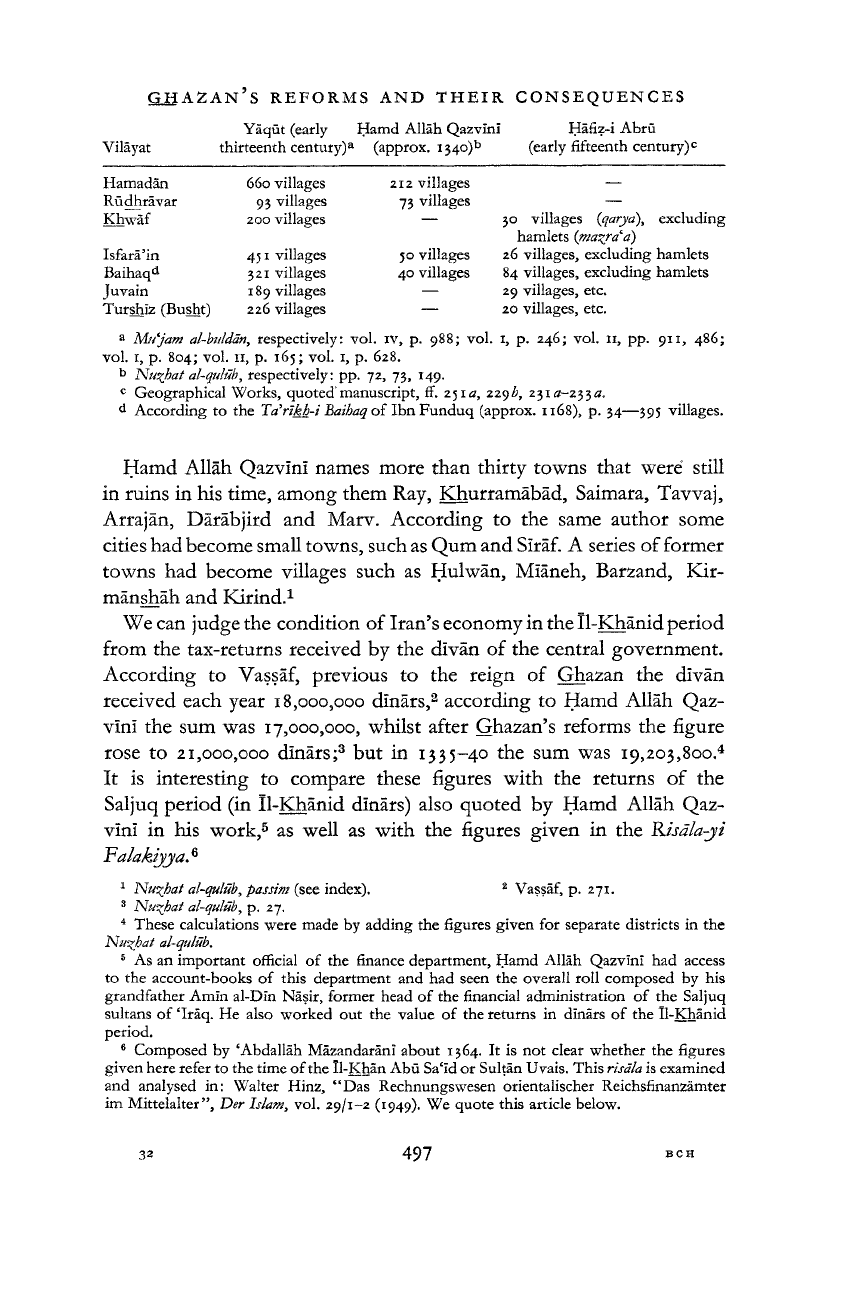
Vilayat
GHAZAN'S
REFORMS
AND
THEIR
CONSEQUENCES
Yaqut
(early Hamd Allah Qazvini Hafiz-i Abru
t
thirteenth
century)
a
(approx.
i34o)
b
(early fifteenth century)
c
Hamadan
Rudhravar
Khwaf
660 villages
93 villages
200 villages
212 villages
73 villages
30 villages
(qarya),
excluding
Turshiz (Busht)
Isfara'in
Baihaq
d
J
u
vain
451 villages
321 villages
189 villages
226 villages
50 villages
40 villages
hamlets
ima^raa)
26 villages, excluding hamlets
84 villages, excluding hamlets
29 villages, etc.
20 villages, etc.
a
Mtfjam
al-bidddn,
respectively:
vol. iv, p. 988; vol. 1, p. 246; vol. 11, pp. 911, 486;
vol.
1, p. 804; vol.
11,
p. 165; vol.
1,
p. 628.
b
Nu^hat
al-qulub,
respectively:
pp. 72, 73, 149.
c
Geographical Works, quoted"manuscript, ff.
251*2,
229b
y
z$ia-2$$a.
d
According to the
Tarikh-i
Baibaq
of Ibn Funduq (approx.
1168),
p.
34—395
villages.
Hamd Allah Qazvini names more
than
thirty towns
that
were still
in
ruins
in his time, among them Ray, Khurramabad, Saimara,
Tavvaj,
Arrajan, Darabjird and Marv. According to the same
author
some
cities had become small towns, such as Qum and Siraf. A series
of
former
towns had become villages such as Hulwan, Mianeh, Barzand, Kir-
manshah and Kirind.
1
We
can judge the condition of
Iran's
economy in the Il-Khanid period
from the
tax-returns
received by the divan of the central government.
According
to Vassaf, previous to the reign of Ghazan the divan
received
each year
18,000,000
dinars,
2
according to Hamd Allah
Qaz-
vini
the sum was 17,000,000, whilst after Ghazan's reforms the figure
rose to
21,000,000
dinars;
3
but in 1335-40 the sum was 19,203,800.
4
It is interesting to compare these figures with the
returns
of the
Saljuq period (in Il-Khanid dinars) also quoted by Hamd Allah
Qaz-
vini
in his work,
5
as
well
as with the figures given in the Risdla-yi
Fa/aktyya.
6
1
Nu^hat
al-qulub,
passim
(see
index).
2
Vassaf,
p. 271.
3
Nu-^hat
al-qulub, p. 27.
4
These calculations were made by adding the figures given for
separate
districts in the
Nu^hat
al-quliib.
5
As an
important
official of the finance
department,
Hamd Allah Qazvini had access
to the account-books of
this
department
and had seen the overall roll composed by his
grandfather Amin al-Din Nasir, former head of the financial administration of the Saljuq
sultans of
'Iraq.
He also worked out the value of the
returns
in
dinars
of the Il-Khanid
period.
6
Composed by 'Abdallah Mazandarani about 1364. It is not clear whether the figures
given
here
refer to the time
of
the ll-Khan Abu Sa'id or Sultan Uvais. This
risdla
is examined
and analysed in: Walter Hinz, "Das Rechnungswesen orientalischer Reichsfinanzamter
im
MittelalterDer
Islam,
vol.
29/1-2
(1949).
We quote
this
article below.
32
497
BCH

IRAN
UNDER
THE
ÎL-KHÂNS
Dïvân
taxes
of
Divan
taxes
Regions
of
pre-Mongol period
Dïvân
taxes
(Risäla-yi
Xl-Khan
state
{Nu^hat
al-qulüb)
1335-40
Falakiyya)
Arabian
'Iraq
Over
30,000,000 3,000,000
2,500,000
Persian
'Iraq
Over
25,000,000
2,333,600
3,500,000
('Iraq-i
'Ajam)
Lur Great
—
90,000
(1,000,000)
320,000
Lur Little
—
90,000
320,000
(i,ooo,ooo)
a
280,000
Azarbaijan
Approx.
20,000,000
2,160,000
—
Arran and Mughan
Over
3,000,000
303,000
—
Shirvan
1,000,000
113,000
820,000
Gushtasfl (delta of the
Approx.
1,000,000
118,500
—
Kur
and
the
Araxes)
Gurjistan and Abkhaz
Approx.
1,000,000
1,202,000
400,000
(Georgia)
a
In
both regions
of
Lur
1,000,000
dinars were collected,
but the
central dïvân received
only
90,000, the
rest being kept
by the
dïvâns
of
the local atabegs.
Dïvân
taxes
of
Dïvân
taxes
Regions
of
the
pre-Mongol period
Dïvân
dues
in
{Risäla-yi
ll-Khan
state
{Nu^bat
al-qulûb)
1335-40
Falakiyya)
Rum (Asia Minor)
Over
15,000,000
3,300,000
3,000,000
Great Armenia
Approx.
2,000,000
390,000
—
Diyarbakr and Diyar Rabi'a
10,000,000
1,925,000
—
(Upper Mesopotamia)
Kurdistan (Eastern,
Approx.
2,000,000
201,500
—
now
Iranian)
Khuzistan
Over
3,000,000
325,000
1,100,000
Fars
Approx.
io,5oo,ooo
a
2,871,200
—
Shabankara
Over
2,000,000
266,100
4,000,000
Kirman and Makran
880,000
676,500
—
Total
b
100,580,000
19,203,800
15,920,000
a
In
310
or
922.
b
In
Il-Khanid dinars. Detailed calculations
and
references
to Nu^fjat
al-qulub
in: I.
Petrushevsky,
Zemledelie
. . .,
pp.
96-100;
see for figures from the
Risala-yi
Falakiyya
Walter
Hinz,
op. cit.
pp.
133-4.
Thus, according to
Hamd
Allah Qazvini, the seventeen regions form-
ing the Il-Khanid
state
paid
the
central
divan
19,203,800
dinars
in
13
3
5 -40
as
against
100,5
80,000
before the Mongol
conquest,
both
sums
being in
Il-Khanid
dinars.
In
other
words the
revenue
of
the Il-Khanid divan was
but 19 per
cent
of
that
of the pre-Mongol
period,
and in some
districts
even less, 9-13 per
cent.
Also
in
the pre-Mongol and Mongol
budgets
sums
which were
paid
to the
divans
of
vassal
landowners
and
sums
498
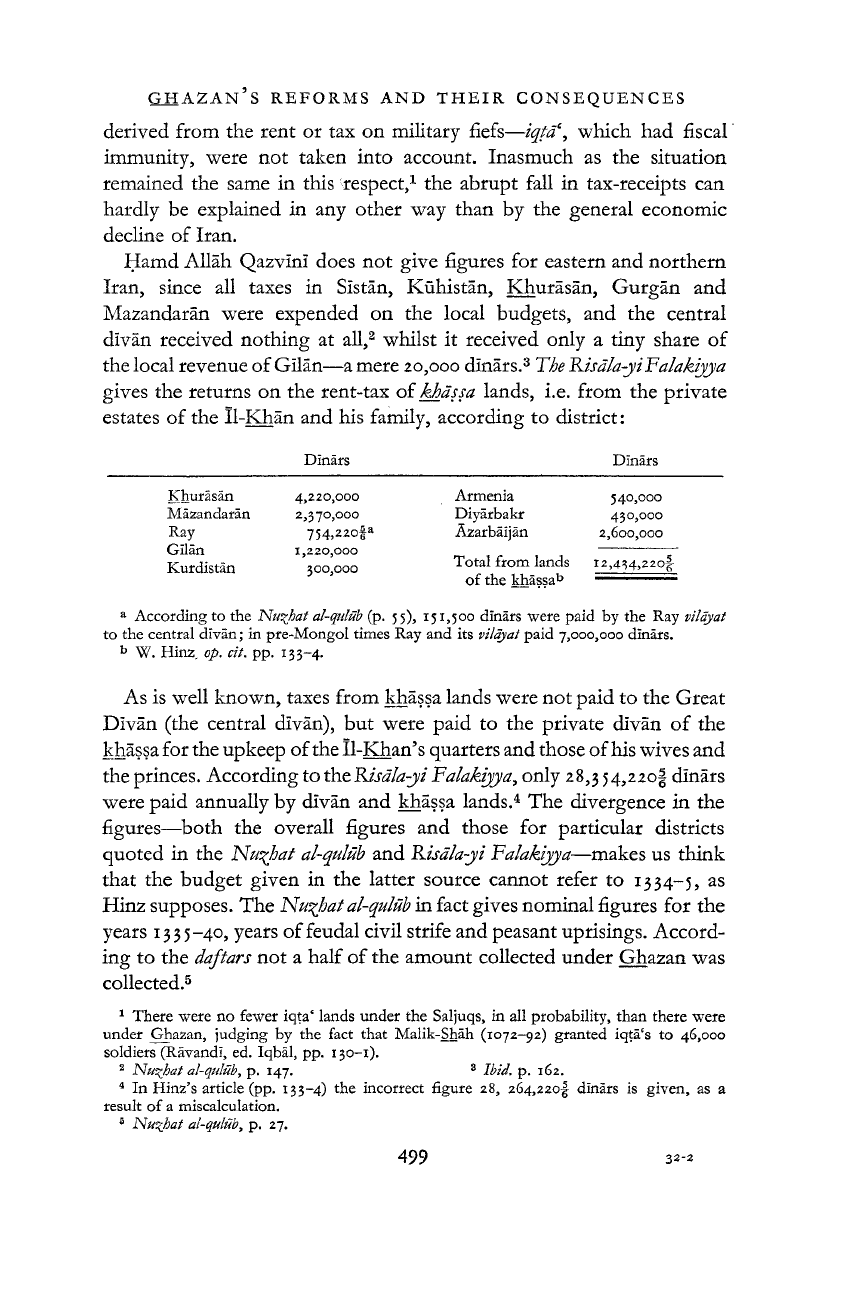
GHAZAN
S
REFORMS
AND
THEIR
CONSEQUENCES
derived
from the
rent
or
tax
on
military fiefs—iqtd\ which
had
fiscal
immunity, were
not
taken into account. Inasmuch
as the
situation
remained
the
same
in
this respect,
1
the
abrupt
fall
in
tax-receipts
can
hardly
be
explained
in
any other w
r
ay
than
by the
general economic
decline
of
Iran.
Hamd
Allah
Qazvini does
not
give
figures for eastern and
northern
Iran,
since
all
taxes
in
Sistan, Kuhistan, Khurasan, Gurgan
and
Mazandaran were expended
on the
local budgets,
and the
central
divan
received nothing
at
all,
2
whilst
it
received only
a
tiny share
of
the
local
revenue of
Gilan—a
mere
20,000
dinars.
3
The Risdla-yiFalakiyya
gives
the
returns
on the rent-tax of khassa lands, i.e. from the private
estates of the Il-
Khan and his family, according
to
district:
Dinars Dinars
Khurasan
Màzandaràn
Ray
Gilan
Kurdistan
4,220,000
2,370,000
754,220fr
1,220,000
300,000
Armenia
Diyärbakr
Äzarbäijän
540,000
430,000
2,600,000
Total
from lands
of
the khässa
b
499
32-2
a
According
to the Nu^hat
al-qulub
(p.
55),
151,500
dinars were paid
by the
Ray
vilayat
to
the
central divan;
in
pre-Mongol times Ray
and its
vilayat
paid
7,000,000
dinars.
b
W.
Hinz,
op. cit. pp.
13
3-4.
As
is
well
known, taxes from khassa lands were not paid to the Great
Divan
(the central divan),
but
were paid
to the
private divan
of
the
khassa for the upkeep
of
the Il-Khan's quarters and those
of
his
wives
and
the princes.
According
to theRisd/a-yi Falakiyya, only 28,3
54,220!
dinars
were
paid annually by divan and khassa lands.
4
The divergence
in the
figures—both the overall figures
and
those
for
particular districts
quoted
in the
Nuchal
al-qulub
and Risd/a-yi Falakiyya—makes us think
that
the
budget given
in the
latter source cannot refer
to
1334-5,
as
Hinz
supposes. The Nu^hat
al-qulub
in fact
gives
nominal figures for
the
years
133
5-40, years
of
feudal
civil
strife and peasant uprisings.
Accord-
ing
to
the
daftars
not
a
half of the amount collected under Ghazan was
collected.
5
1
There were
no
fewer iqta* lands under
the
Saljuqs,
in all
probability,
than
there
were
under Ghazan, judging
by the
fact
that
Malik-Shah
(1072-92)
granted iqta's
to 46,000
soldiers (Ravandi,
ed.
Iqbal,
pp.
130-1).
2
Nu^hat
al-qulub,
p. 147.
3
Ibid. p. 162.
4
In
Hinz's article (pp.
133-4)
the
incorrect figure
28, 264,220^
dinars
is
given,
as a
result
of a
miscalculation.
5
Nut^bat
al-qulub
9
p. 27.
